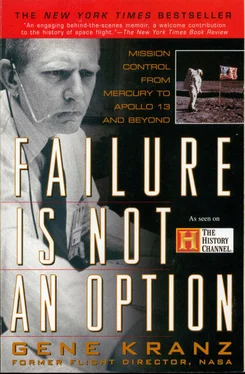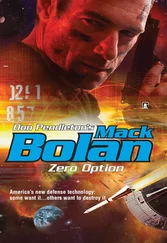The launch complex from which we would fire the Redstone consisted of the launch pad, service tower, and a blockhouse for launch site command and control. Servicing the pad was a network of power and communications cables, and pipes carrying fuel and other fluids. The blockhouses were igloolike structures that sat about 230 meters from the pad and looked somewhat like squat World War II pillboxes. Atlas blockhouses were a bit different—twelve-sided concrete bunkers with walls three meters thick and domed tops, embedded in thirteen meters of sand. Earlier blockhouses used a viewing slit with a thick quartz/glass window. Later on periscopes were added; they afforded a view of such things as the fuel tanks and cable trenches. The blockhouses had to be close enough for direct viewing and far enough from the booster to survive an explosion. (Five percent of the early boosters exploded shortly after liftoff.)
The blockhouse team was a mixture of German rocket scientists, former Army technicians, and booster contractors. The Germans were most often found talking in their native language, huddled over their displays and praying for things to go right. In addition to von Braun’s colleagues, the blockhouse capsule engineers were drawn from a broad talent pool, mostly from aircraft (soon to be called aerospace) contractors. Kraft’s team was made up of engineers who came from all sorts of backgrounds, put together like a pickup softball team. The capsule engineers came from the NASA Space Task Group, network controllers from the Air Force, facility technicians from Bendix, and the Mercury Control Center CapComs from the initial group of seven astronauts. Three-man operations teams were deployed to the thirteen Project Mercury manned tracking stations to provide global tracking, data, and voice communications data coverage. The leader of the three-man team was the CapCom, and he was responsible for site mission readiness, real-time mission support, and status reporting to the Mercury Control flight director. During the manned missions he provided the communications with the astronaut in the capsule, hence the term “CapCom.”
The teams at the thirteen manned tracking stations were provided by Kraft’s operations organization. With high-risk time-critical decisions, the astronaut corps believed that only astronauts should talk to the astronaut in the capsule. In the Mercury Control Center and at the blockhouse, CapComs were selected from the Mercury astronauts and they were often sent to tracking stations designated as mission critical.
During this period, the American space program drew on some military resources as well as those of NASA. By contrast, the Russian program was part of their military. Soviet hardware, software, and personnel were military, albeit with some modification—spacecraft instead of warheads sitting on top of boosters that, like our Atlas, originated in military programs developed for strategic warfare. Over time the Russian effort would become somewhat more civilian in nature, but from inception, NASA’s operations would be separated by a kind of firewall from military operations and personnel.
In the first decades of the race into space the Russians enjoyed the advantages of running a program powered by the virtually unrestricted resources and funding of a military that, in a command economy, came first in economic priority. We were on a somewhat more modest footing in the early days. That would change dramatically thanks to President John F. Kennedy and Vice President Johnson pushing for the funding and resources that would enable an explicitly civilian space program to succeed.
In Mercury Control the only controllers reporting administratively to Chris Kraft were the trajectory operators, Tecwyn (Tec) Roberts, and Carl Huss, whom I had yet to meet; Howard Kyle, who doubled for Kraft at the flight director console; Paul Johnson; and myself. The capsule engineers assigned to work with the MCC team understandably focused on hardware rather than flight operations and had their hands full checking out the spacecraft in Hangar S, and they looked at training in the Mercury Control Center as a waste of their time. The core of the engineering staff was based at Space Task Group headquarters at Langley Research Center. When McDonnell Aircraft sent a capsule to the Cape the engineers would come down and check it out in Hangar S.
Despite a certain amount of confusion about who should be doing what, since we were inventing it all as we went along, we were moving quickly to the crunch point. To my dismay, two days before launch at the readiness review, Johnson took me aside and said he would not be there. He had to go to the Canary Islands to work out a tracking site problem. He wished me good luck.
November 21, 1960, Mercury-Redstone 1
Only one month and four days after I was hired, I was at the procedures console. Thanks to Johnson’s unflagging coaching and the training we had done, I had no problems and felt comfortable with the mechanics. But I had a long way to go before I would have that sense of “being ahead of the airplane” or “ahead of the power curve” as pilots put it—having the experience to anticipate what could happen rather than just reacting to what was happening at the moment.
As the countdown proceeded, I noticed a change in the intensity of the atmosphere in the control room. I had felt that before when I signed off my aircraft—accepted it as ready for flight—at Holloman. Although the job was different, the emotional content was the same. Controllers were going through the same gut churning as we had had prior to a B-52 test flight. During a hold in the countdown to fix a leak in the Redstone’s hydrogen peroxide system that fueled the control thrusters, Kraft turned to me and said, “How about getting me a couple of cartons of milk from the roach coach?” (Mercury Control, like all the other Cape facilities, was out in a vast palmetto swamp, about half a mile off the main road. A lunch wagon, known as the roach coach, pulled by a pickup truck, made its rounds to the test stands, camera trackers, and other stations. The loudspeakers would announce its arrival when it stopped at Mercury Control three times each day. The menu was pretty limited—but it did offer milk.) For the first time I realized that behind Kraft’s calm exterior he had the same sensations I felt—of squirrels running around in my stomach—as we approached launch.
The launch countdown progressed without any major incident. As liftoff approached, I leaned back and peered at the video image on Kraft’s console coming from a camera focused on the Redstone standing on the launch pad. Precisely at zero on the clock, there was a great cloud of smoke. Kraft looked startled, and then he leaned forward intently. The TV cameraman momentarily lost track as he panned the camera upward, and, for a few seconds, there was nothing on the screen but a smoky sky. From my position, it looked much like the rockets I had launched from aircraft. I was surprised at how quickly the Redstone had accelerated and moved out of sight.
Then after a few seconds the camera panned down. Although smoke still obscured the launch pad, the vague outline of the Redstone was still there. Kraft’s face was incredulous. He stammered for a few seconds, then called out, “Booster, what the hell happened?”
Our booster engineer in the control room came from the Marshall Redstone team. After liftoff he was responsible for reporting booster status—engine and guidance—to Kraft’s team. If something was wrong he was supposed to give us a heads-up so the trajectory people in Mercury Control could better assess what they were seeing on their radar plot boards. Now he reverted to his native German as he tried to figure out what happened and, more importantly, what the blockhouse team should do about it. All hell broke loose. The Redstone had lifted a few inches off the launch pad and then the engine shut down. By some miracle, the rocket had landed back on the launcher cradle.
Читать дальше












